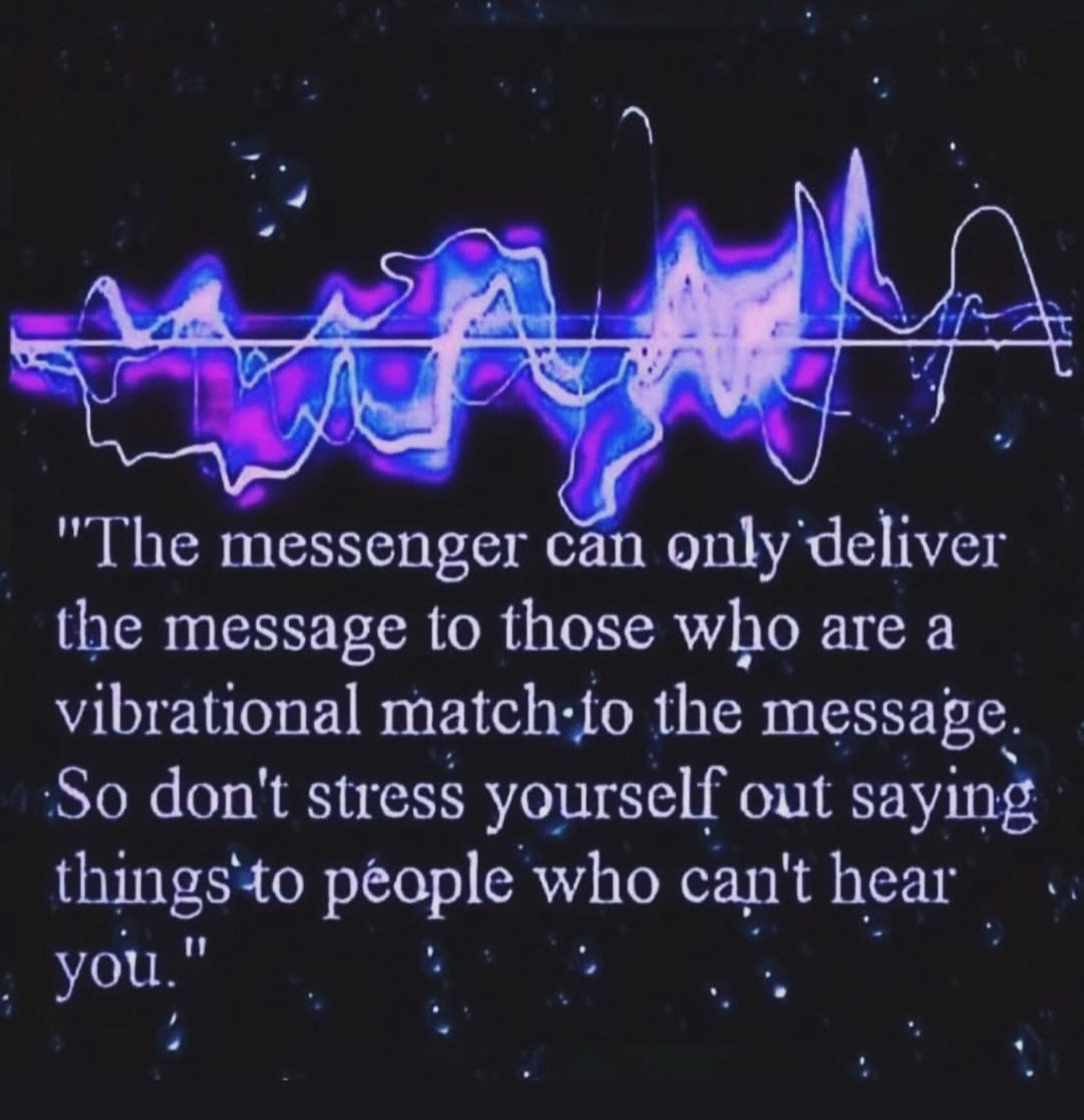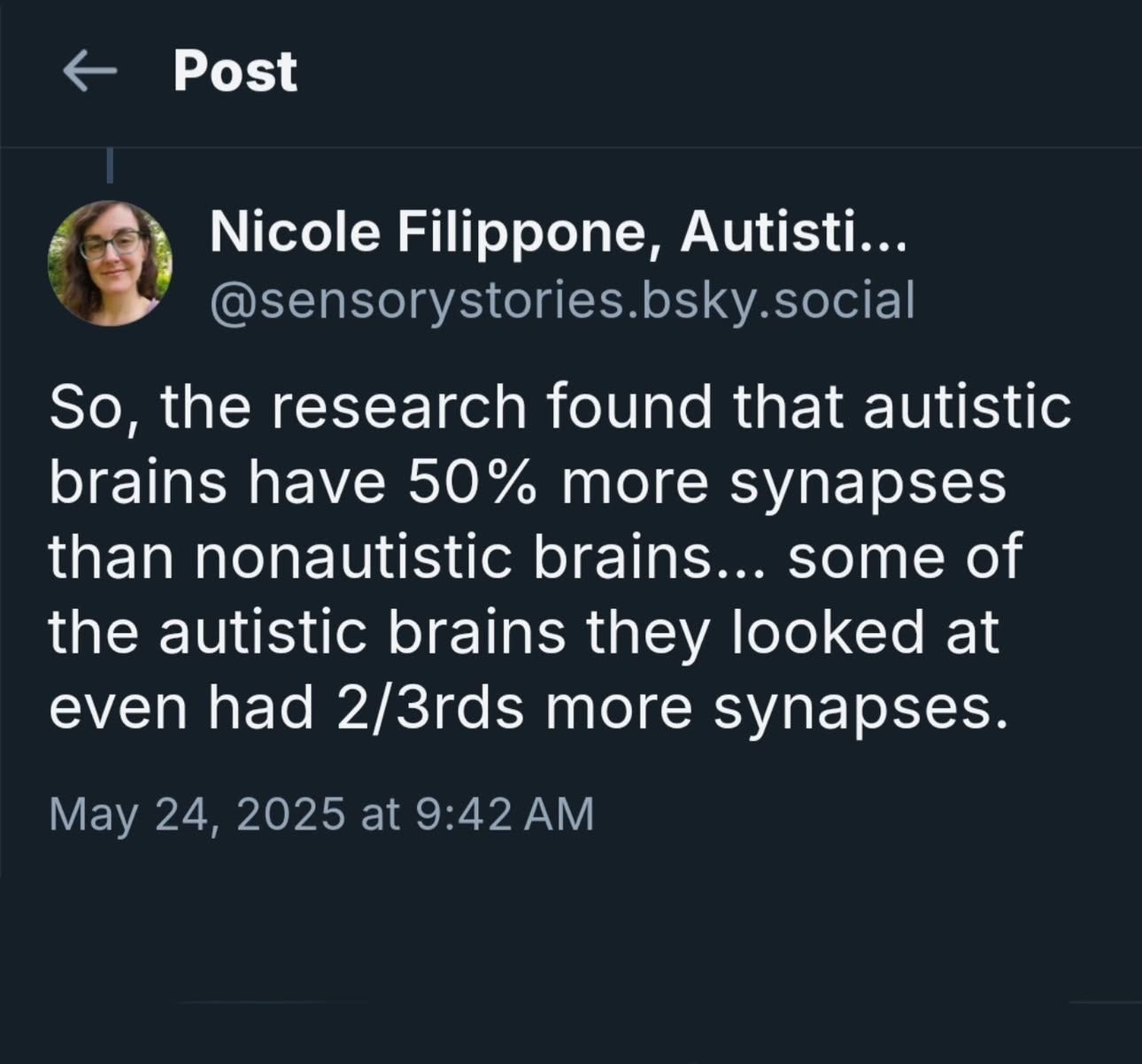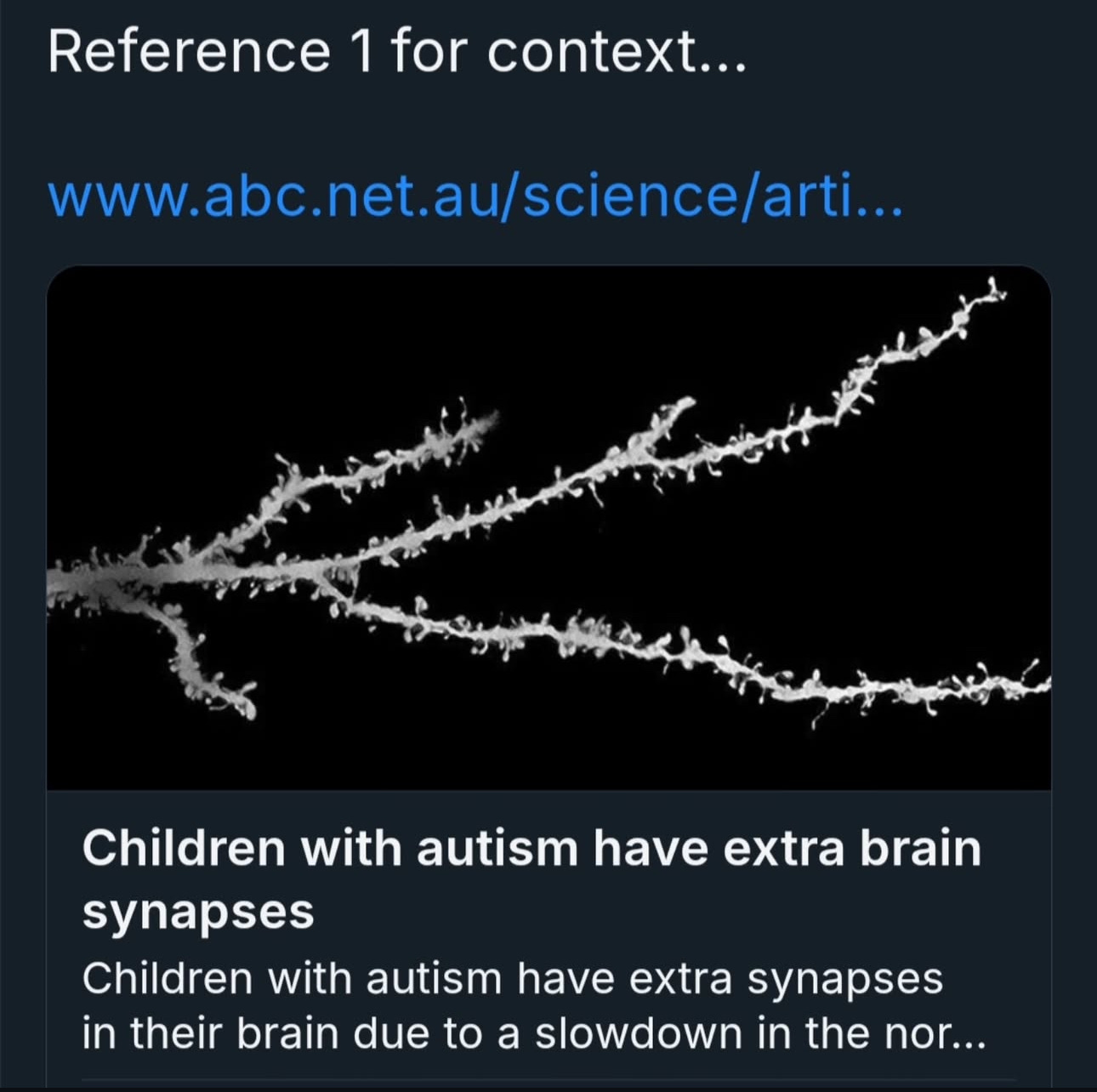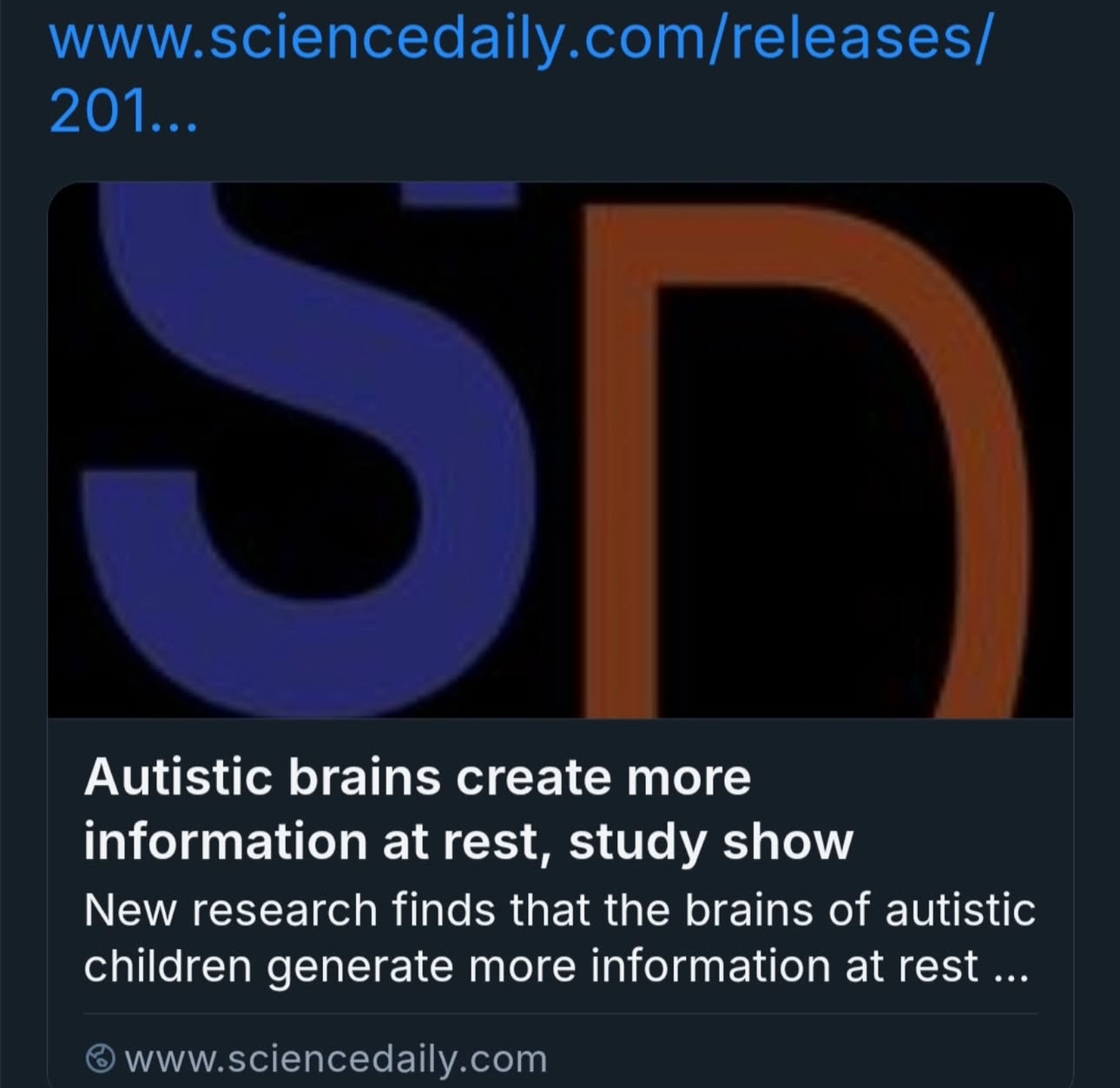The Frequency of Belonging: On Autistic Memory, Refusal, and Kinship
Reclaiming neurodivergent ways of knowing, connecting, and surviving in a world that demands translation.
Autistic difference isn’t disorder—it’s memory, resilience, and relational depth. This piece explores the harms of pathologising neurodivergence and calls for kinship beyond productivity, performance, or proof.
Introduction: The Frequency Mismatch
It begins, as these things often do for me, with a meme. A square of text against a muted backdrop, algorithm-delivered and almost missable: “The messenger can only deliver the message to those who are a vibrational match.” It’s not framed as autistic. Not labelled, footnoted, or situated. But I recognised it instantly as one of ours.
There’s something in that phrasing — vibrational match — that captures, with uncanny precision, what so many of us feel when we try to speak across the gap. For those of us who process language gestalty, or who communicate relationally, metaphorically, or through pattern and resonance rather than step-by-step instruction, it’s not just a communication style — it’s a sensory ecology. A full-bodied frequency. We don’t simply say things. We build them, or hold them, or gesture toward them with constellated fragments and reference points. And when we’re met with confusion, dismissal, or the blank politeness of “I don’t follow,” it’s rarely a matter of logic. It’s a mismatch in wavelength. The message can’t land if the channel isn’t tuned to receive it.
This isn’t a defect. It’s a difference. But in a world that treats deviation as error and misunderstands complexity as disorder, the pressure to justify ourselves — to explain, translate, reduce — becomes suffocating. Which brings me to the deeper unease beneath the meme. Because behind the poetry of vibration is the quiet desperation of a question I can’t shake: when researchers study autistic brains, when they parse our scans and our signals, are they doing so in order to listen — to truly attune to our way of being — or are they looking for ways to erase the difference? To prune the signal. To flatten the frequency. To make us easier to manage, at the cost of what makes us ourselves.
What the Memes Reveal — and Conceal
The images circulate widely now—fragments of data reframed as truth, captioned, colour-coded, turned into sharable proof. There’s Temple Grandin’s brain scan, side-by-side with a “neurotypical” comparison. The luminous tangle of visual cortex activation — not disorderly, not diminished, but differently lit. Grandin, whose story has become a kind of talisman for autistic acceptability: See? I’m autistic, and I work at a job. I contribute. I translate. Her brain, in this image, becomes both icon and exception — a singular snapshot held up to represent a spectrum.
Then come the tweets about synaptic density. Studies with small sample sizes, post-mortem tissues from autistic children, and a finding that catches fire in the imagination: too many synapses. A brain that didn’t prune enough. A system that generated more connections than it “should.” And the implication, not always said outright but threaded through commentary, is one of inefficiency — that autistic brains are doing too much with too little order. That what looks like richness might in fact be noise.
Other studies echo this idea: resting-state fMRI scans showing that even at rest, autistic brains are more active, more internally connected, more “on.” Some interpret this as overactivity, as something to regulate or contain. But others — particularly those of us living these brains from the inside — know there’s a different story here. Not excess. Not dysfunction. But intensity. Density. A deep and layered inner world where thoughts interlace like mycelium.
And still, we share the memes. We circulate the science. Look, we say, this is why I am the way I am. See? It’s real. There’s a longing stitched into every retweet, every share: not for validation from institutions, exactly, but for a kind of safe recognition. We want to be believed. We want the difference to be legible. And perhaps, at times, we want it to be special enough that it buys us the right to exist without shame.
But here is the soft edge of the question: why do we still need to prove it? Why does our value hinge on exceptionality — on brain scans and productivity, on evidence of our difference being either useful or fascinating? What if none of that was required? What if the truth of our lives — how we see, feel, connect, resist — was enough?
What if our worth isn’t in being exceptional, but in being here?
The Dangerous Allure of ‘Fixing’ Brain Difference
There’s a particular chill that runs through me when I read about pruning studies — not because the science is flawed in itself, but because I already know how the story will be told. The finding is deceptively simple: that autistic brains appear to undergo less synaptic pruning during development, leaving behind more connections, more noise, more density. It’s framed as curious, as significant, and — inevitably — as something to be fixed.
And that’s where the unease sets in. Because I know what follows. I’ve seen it before.
A difference becomes a deviation. A deviation becomes a deficit. And a deficit becomes a target for intervention.
What will researchers do with this knowledge? What will they design in its wake? A drug to stimulate pruning in autistic toddlers? A “neuroplasticity programme” to redirect development toward normative baselines? A new round of early intervention therapies, slick with language about “optimising outcomes,” but built on the same old premise: that the autistic brain must be shaped into something more acceptable, more manageable, more typical.
I’ve lived through the consequences of those logics. We all have. The history is not distant or abstract — it lives in the present tense. Early detection led to surveillance. Behaviourism taught us to mask, to override our instincts, to perform neurotypicality even when it hurt. Normalisation wasn’t care; it was erasure dressed in the language of support. And still, these cycles repeat — new research, new tools, same assumptions: that we are wrong as we are. That our difference is a problem to be solved.
But this difference — this refusal to prune, this keeping of connections — might be protective, or generative, or simply another way to be. It might mean that we sense more, hold more, feel the world more vividly. It might be why we carry myths in fragments and build meaning out of metaphor and echo. But in the hands of those who see deviation as disorder, it becomes a flaw to be corrected.
That is the danger: not the knowledge itself, but the frame in which it’s received. The way science can slip from description into prescription — and from there, into discipline. Not of behaviour, but of the brain itself. And in that discipline, something vital is always lost. Something that cannot be measured in data sets or scans. Something that might, in fact, be the very thing that makes us who we are.
What Survives, Serve
We are not developmental errors.
We are adaptive memory.
This is the thread running through both Reser’s Solitary Forager Hypothesis and No Place for Autism? — that what society calls pathology may, in fact, be persistence. A lineage. A memory carried not in myth but in matter. Autistic ‘traits,’ rather than being glitches in the system, are ancient adaptations shaped by evolution to serve human communities in ways that modern norms have simply forgotten how to read.
According to Reser’s work — and my work in No Place for Autism? — autistic cognition didn’t emerge in error. It was shaped under the conditions of deep time. The solitary forager: pattern-seeking, silence-loving, hyper-attuned, able to roam, to observe, to catalogue the living world in intimate detail. Not a misfit. Not broken. A vital node in the collective. Someone whose mind was built to wander, to witness, to remember the way home when others were lost. Sensory sensitivities weren’t liabilities in this context — they were tools of precision. Gestalty communication wasn’t confusing — it was the root of story, ritual, and relational transmission.
When we carry these ways of being forward into the present, we carry not malfunction, but inheritance. What has survived has done so because it serves. And even if the world around us has shifted — even if the pace has changed, the signals distorted, the rewards contingent on performance — the structure remains. The architecture of an autistic life is not a broken scaffold. It is a carefully selected variation, a deeply embedded offering from evolution to the species as a whole.
And so when we are asked, again and again, to make our difference smaller, quieter, easier to manage, we must ask in return: easier for whom? To what end? Because pruning away what’s been chosen over millennia is not therapy — it is erasure. It is the loss of a form of knowing that the human world may soon desperately need.
We are not late arrivals. We are not outliers. We are the memory of other ways to be. And in that memory, there is resilience. There is pattern. There is service.
The Myth of “Earning a Living” and the Extraction of Worth
There’s no critique here of Temple Grandin the person. She is, by every account, someone who has carved out space in a world that offers little grace to those who move and think as we do. She made visible what was long kept hidden. She spoke, when few others were allowed the mic. No — the critique is not of Grandin the individual. It is of Grandin the brand — and more importantly, of the forces that built that brand, decided what to amplify, and to what end.
Because when Grandin is held up as the emblem of autistic success, it’s rarely her inner life, her sensory world, or her relational truths being honoured. What’s celebrated is that she works. That she designed something of industrial value. That she found a way to be useful — economically, logistically, productively — within the dominant system. And this is what is offered to us as hope: See? You too can earn your place. You too can be palatable — if you produce something of measurable worth.
But this is a deeply narrow promise. A conditional one. It says: you may belong, if you contribute. You may stay, if you mask. You may be spared, if your difference can be translated into capital. And for those of us who can’t — or won’t — perform that translation, what then? What of those who don’t build slaughterhouses, who don’t fit into a STEM pipeline, who don’t speak in a way that reassures neurotypical audiences that everything will be alright?
We see the extraction at work when autistic children are steered toward vocational utility rather than flourishing. We see it in the charities that raise funds “for autism” but not for autistics. We see it in the way rentier wealth — landlords, shareholders, speculators — is never asked to prove its worth, whilst disabled life is interrogated at every turn. Who really earns a living? And why must we earn our right to exist at all?
What gets erased in this model are those who resist performance. Autistic people who don’t mask. Who don’t engage in capitalist work. Who live communally, creatively, messily, or in ways that challenge the very terms of worthiness. Their lives matter no less — but in the logic of extraction, they are made invisible.
So we say clearly: Autistic life is not conditional on productivity. It is not contingent on marketable skill, nor on palatability, nor on the ability to become someone else’s brand. Our value is not a footnote in an economy. It is foundational to a world worth living in.
From Exception to Kinship
There’s a deep ache under the “I’m special” narrative — one that doesn’t always get named. So many of us carry it, this need to justify our presence, our difference, our way of being in the world. And even when the narrative is cast in a positive light — giftedness, savantism, creativity, high empathy — it still pivots on the same axis: prove you belong. Be exceptional. Make it worth their while to keep you around.
But what we often mean when we say “I’m different” is something far softer, far more vulnerable: I want to be held. I want to be met. I want to be loved, not despite who I am, but because of it — or even regardless of it.
This is where the myth of the double empathy problem collapses in on itself. The issue isn’t that autistic and non-autistic people are fundamentally incompatible — it’s that too often, we’re asked to perform legibility, to do all the bridging, to explain and reshape ourselves in the hope of receiving what others are freely given: care, companionship, belonging. What we want — what anyone wants — isn’t so mysterious. We want connection without spectacle. Intimacy without evaluation. To love and be loved not because we’ve proved our usefulness, or amused someone with our quirks, or “progressed” far enough in therapy — but because our being is enough.
It’s not what shows like Love on the Spectrum parade: that carefully curated awkwardness framed for the neurotypical gaze, all wide-eyed innocence and teachable moments. That’s not love. That’s performance. That’s packaging vulnerability for consumption. What we’re reaching for is something quieter, slower, more reciprocal. A love that can sit with silence. A love that doesn't ask for translation. A love that recognises that sensory overwhelm, shutdowns, or unusual pacing aren’t failures of intimacy, but expressions of it.
What might a culture look like where neurodivergent people didn’t have to prove anything to be included? A world that understood presence as participation. That valued the companionship of someone who listens with their whole body, or communicates in fragments, or speaks only in metaphor. A world where kinship wasn’t measured by how well you fit, but by how well you were held. A culture of interdependence, where your needs weren’t seen as obstacles but as invitations to deepen care.
What we need isn’t affirmation through exceptionalism. What we need is kinship that refuses to ask us to be anything other than what we are.
Final thoughts …
We do not need to be pruned.
Let that be said plainly. Let it be the refusal that echoes through every scan, every study, every well-intentioned intervention that seeks to pare us down to something more manageable, more typical, more tolerable. We are not here to be made easier. We are not here to be made the same. We carry something too ancient, too vital, too intricately formed to be cut away.
There is a legacy to our being — not in diagnosis codes or behavioural inventories, but in memory. In the deep evolutionary memory of difference that has served humanity again and again. In the sensory memory of a world too often dulled by speed and noise. In the ancestral memory of other ways to be: slower, more attuned, relational, rhythmic, exacting in pattern and porous in presence. We are not new. We are not broken. We are not alone.
And so we reclaim. Not just rights or recognition, but ways of knowing. Ways of connecting. We reclaim gesture, metaphor, silence, stim, stare. We reclaim solitude as sacred, not pathological. We reclaim emotional truth in all its nonlinear unfolding. We reclaim language that spirals and shimmers and doesn’t always land where it’s expected to. We reclaim ourselves from the grasp of productivity metrics and developmental checklists. And in doing so, we reclaim each other — in kinship, in defiance, in care.
Somewhere in the mind’s eye, the solitary forager stands in the clearing. Not isolated, as the name might suggest — but vigilant. Rooted. Watching the land shift. Holding the map in their bones. Their presence is not a mistake. It is a signal. A continuity. A promise.
Not everyone will see them. Not everyone will hear the message. But some will. And those who do will understand: this way of being was never meant to be pathologised. It was meant to be preserved. Because it holds open something the future might yet need.








